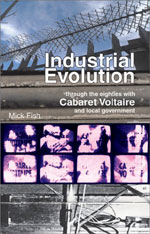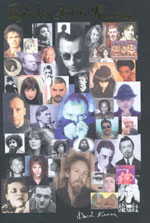Strange Obsessions and Secret Histories
| |

| Mick Fish's Industrial
Evolution: through the eighties with Cabaret Voltaire [Poptomes/SAF, £9.99] is a strange book which mixes musical history and personal anecdote in an ultimately unsatisfying way. Leaving university in London, Fish goes to work at a council depot, where he discovers a bunch of slackers, skivers and mentally unbalanced individuals who would rather devote their hours of employment to pornography, stealing and going walkabout than getting on with their jobs. Fish feels obliged to go into some detail of language, subject and politics of the depot; as someone who - like most people reading the book I suspect - have done their time in a dead end job [we all did in the 80s; in my case it was being a hospital porter] this is neither interesting nor revelatory.
Better still are the sections where Fish travels to Sheffield and gets to know not only Cabaret Voltaire but most of the groups in Sheffield of that time. I wanted to hear more about Clock DVA, The Box, Chakk, Hula and They Must Be Russians; less about The Human League, ABC and Heaven 17. Although the anecdotes of drinking and recording sessions are amusing, the real interest lies in the titbits of information about the half-forgotten bands of the time, although Fish chooses to be simply opinionated rather than informative when it comes to bands, like Psychic TV, he doesn't like. The real meat of the book is relegated to the appendices, which contains the interviews which made up the book's previous incarnation as The Art of the Sixth sense: Cabaret Voltaire, which was SAF's first publishing venture [Fish is the Editor]. These, along with more detailed write ups of some of the other bands would have made a more fascinating exploration of the 1980s. This hodgepodge memoir is too unfocused and self-obsessed to really hold the reader's attention. In fact the SAF volume Tape Delay, which almost gets put down in Industrial Evolution, actually ends up as a better book - despite its broad remit - because of its focus on the music, which of course comments on the society that produced it, without endless anecdotes of speed, drink and anti-Thatcher rants. |

| “
It wasn't only Mick Fish that Psychic TV managed to wind-up, they seemed to annoy and upset anyone and everyone they could, through their appropriation of proto-nazi and sado-masochistic imagery, their over-serious declarations, and their general cult trappings, which resulted in an army - Thee Temple Ov Psychic Youth - of sad young men with shaved heads around the country slavishly collecting limited tape and LP recordings of every Psychic TV gigs and spraying the band's insignia on concrete wherever possible. Exeter's museum still has PTV insignia clearly visible! Because of this image problem and the endless bleating of Genesis P. Orridge, along with the endless documentation of noisy gigs they seem to be a neglected part of musical history. I still have an intriguing issue of Subvert fanzine which contains some excellent interviews and articles about the band. People also seem to forget about the haunting pair of mainstream LPs the band put out. And, personally, I think the endless tapes and live recordings were just a great marketing scam... P. Orridge was a salesman ahead of his time. Anyway, in the wake of Psychic TV breaking up, and Genesis P fleeing to the States on trumped up obscenity charges - thanks to Channel 4 - came Coil and a shed load of other post-industrial groups, including Current 93 and Nurse With Wound. SAF's new title England's Hidden Reverse: A Secret History of the Esoteric Underground [£35.00 ltd edition (cheaper from Amazon)] deals with this trio of bands and their musical, sexual and occult obsessions. It briefly goes back to the childhood upbringing and schooling of the bands' key members of, but swiftly moves forward to Throbbing Gristle and the Psychic TV fallout and what followed. What's strange about the three bands and the wonderful music they often make, is their apparent need to justify it with all sorts of esoteric and occult gobbledygook. They replace one set of mainstream social & religious constructs with a hundred others, all far harder to swallow or believe! They also at times are used to justify the low points in the bands' artistic output: hard to criticise bad poetry and lyrics, naive art, when they are presented as the work of a demon, or the result of a ritual to gather up sexual energy. Astral projection, sex magick, channelling, moon energy, alchemy, not to mention the expected Crowley, Osman Spare, Lovecraft and Arthur Machen, all feature here. In fact what is so amazing, is that out of such strange obsessions can come such glorious and intriguing music. Coil's electronica and drones often don't do much for me, but Nurse With Wound's collages and experiments in mood and sonic texture are fascinating and addictive. Current 93's avant-folk can grate, as can his Noddy and Tiny Tim obsessions [is it him or me being po-faced?] but when he's good he's good; and when Current 93 and Nurse With Wound join forces the end result often exceeds all expectations. And of course, woven into this story are a thousand other bands, moments and events which make for great reading. A Secret History is recommended for this more than the endless esoterica - but recommended it is: it's a wealth of musical information and history. |
|
“
If you're interested in creativity in a more general sense, then I recommend John Tusa's On Creativity [Methuen, £14.99] which is subtitled Interviews exploring the process. The book does what it says - thirteen artistes, including painters & sculptors, composers, writers, architecture and film-makers - are quizzed about their work and the whys and wherefores of how they make it. Tusa is a thorough and gentle interviewer who is able to push through the self-mythologising and cod-political poetry of the awful Tony Harrison to get to the grist; he also manages to make the awful daubings of painter Howard Hodgkin sound interesting and informed - no mean feat, in my humble opinion. Frank Auerbach is clear and forthright about working and working away; Anthony Caro theorises about the relation of [his] sculpture to the public; composers Elliott Carter, Ligeti and Harrison Birtwistle divers and various about how and why they compose what they do. And David Sylvester is particularly erudite and informed about the role of the critic and reviewer. His interview suitably ends the volume, apart from Tuma's own note/essay ļOn Interviewing'. It's a fascinating and lively read, although as ever with these things the people you don't know about never make as much sense as those you do! | |

| “
The same could be said about Mike Evans' N.Y.C. Rock: Rock'n'Roll In The Big Apple [Sanctuary, £12.99] doesn't make a lot of sense either. Another book admirably summed up by it's subtitle, the book's a pretty straightforward history of rock music since the 1950s. It moves from folk rock to punk via disco, and pogos on into new wave and avant-rock territories, before losing my interest with descriptions of the current crop of wannabees. As you can imagine, after the obligatory Dylan & co. and Velvet Underground sections, I was most interested in the sections where punk mutates into experiment: Television and Talking Heads, perhaps Jonathan Richman. One of my criticisms of the book is it simply isn't critical - these incredible bands sit in the dubious company of the Cars and the B-52s! Neither does it really tell the reader much they probably won't know, nor particularly contextualise it. The sections on Sonic Youth don't really pick up on the band's more experimental influences; the chapter on ļalt. rock' includes jokes like They Might Be Giants [described here as ļone of the quirkiest of New York bands' - you what?!] and the mainstream popstar Lenny Kravitz. There's little exploration of the loft scene, or the music that evolved around The Knitting Factory or is currently being made at The Tonic - and no doubt a load of other places I don't know about. John Zorn and Bill Laswell, two figures I know I'm not alone in regarding as seminal New York movers & shakers, get half a page between them. And throughout the book there is factual error after error, not to mention an impressive array of typos! New York's musical strength has always been its incredible diversity and hybridity. It's rock music has always been informed by the likes of minimalism [Philip Glass via Laurie Anderson], the visual arts [abstract expressionism onwards], performance poetry at places like St Marks, jazz, improv [John Zorn et al] and its folk and hippy heritage - from Dylan, Tim Buckley, Fred Neil and others onwards. This book is too linear, it's tone too flat, to explore this diversity - and it's frankly pretty dull and boring as a result. New York and the music it produces are far more exciting than this book suggests. © 2003 Rupert Loydell |